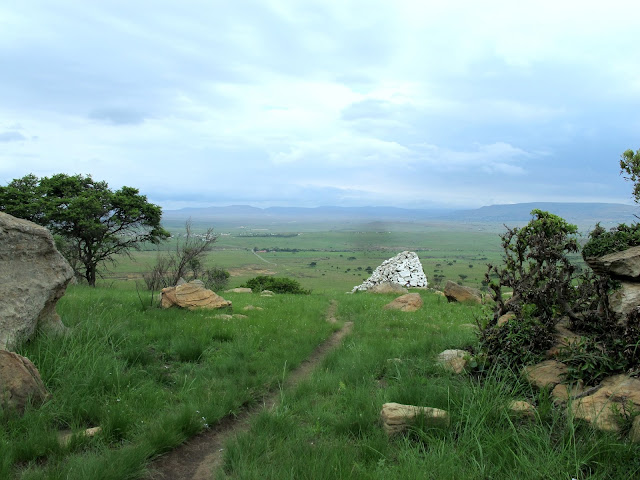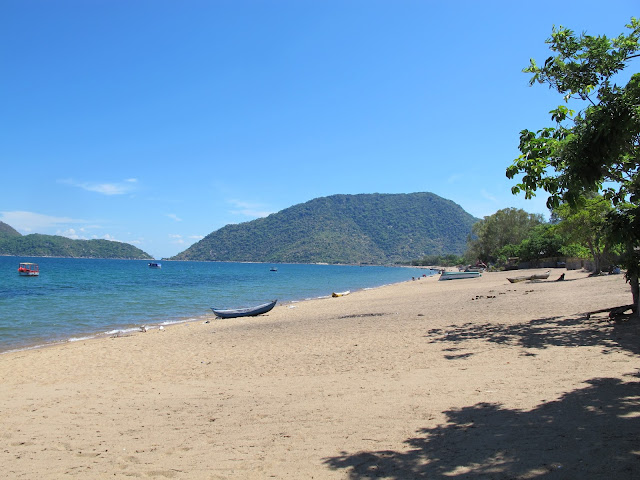 |
| The museum at Rorke's Drift, scene of the famous siege |
After our tour of the Anglo-Boer battlefield of Spioenkop (see part 1) we headed east and back in time to the Anglo-Zulu Wars. To British imperial treachery and arrogance and to bravery, fortitude and warrior spirit from both nations of young men fighting over yet another mountain top.
The Penny Farthing, Dundee
About an hour and a half east of Ladysmith, deep in the
green valleys of KwaZulu Natal and on the edge of Zululand we finally reached the
Penny Farthing farm and guesthouse and our host and guide Foy (so
called because the first farmhand to greet the newborn had a lisp and
exclaimed 'a foy!'), took us into his home.
The octogenarian widow Foy is one of
the leading historians guiding visitors through these battlefields.
His family have lived and farmed here since the Voortrekkers left the Cape in the mid 1800s, surviving
the scorched earth of the British during their war on the Boers and
today fighting to see through the end of the worst drought in
decades. The wide empty fields were a blaze of luminous green grass
as the first rain in months had just arrived, although as Foy showed us, just
below the surface the red earth remained bone dry.
After a delicious home-cooked dinner
around a grand dining table looked over by black and white photos of
several generations of bearded ancestors, we retreated for a gin and
tonic and a documentary film. In it the true stories of the battles were
told, the complex history of the Zulu nation was outlined, the
problems of weaponry and technology examined, the reasons for the
conflict explained and the myths of Michael Caine's Hollywood epic,
Zulu, were dismissed.
The rains continued to patter atop the
steel roof of the old house and across the horizon distant flashes of
lightning flared. That night, 30km from the nearest town, I slept deeply and dreamed of green valleys and red-coated armies, of fires and songs,
strong black men running through the night and a past Africa of
competing clans and colonies.
After breakfast we all packed into the trusty Yaris and set forth for Zululand. The road quickly turned to
gravel and as we passed field after field spattered with anemic
miele corn, Foy told us of the poor harvest that was to come after this devastating
drought. Soon we crossed into the valley divided by the Buffalo River, the borders of Shaka's Zululand.
 |
| The quiet valley of Rorke's Drift |
 |
| British memorial at Rorke's Drift |
 |
| A more modern Zulu memorial at Rorke's Drift |
Rorke's Drift
First stop Rorke's Drift. The tiny
field hospital and mission station manned by a small band of British soldiers which withstood an army of
several thousand Zulu warriors. It's remarkable how small it is. How humble.
The British didn't bother with their usual grandeur this close to
the borders that they had previously promised not to cross.
As Foy talked us through the museum
using his walking stick to point to the crucial front lines – first
the garden, then the veranda, the doors, the windows - the sight of
thousands of young Zulu warriors burst into the imagination. Having
run a half marathon overnight from the next valley over (there were
few horses here in those days due to the devastating African Horse
Disease) the men launched themselves on the small garrison determined
to wet their spears with blood and prove themselves in battle. The British redcoats guarding the
field hospital sought to stand their ground, summoning their own
bravery and strength in a last stand that remains one of the most
lauded of the era.
Now this valley is serene, un-manicured
but pretty, not wild nor dramatic. We sat and soaked in the scene
under a tree with a simple picnic followed by cups of tea. The
occasional villager strolled by on their way home, a
child played in the street while a woman swept her stoep.
Isn't this what everybody wants to do?
To sit beneath a tree in good company with a cup of tea and a
sandwich while the world quietly turns? Is this calm humdrum of everyday village life, of homemakers, elders and children going about their day, what the men dreamed
of as they lay dying in the grass?
Such a gentle valley filled with the dead of so many. And yet it felt so peaceful there, that without Foy's brilliant narrative one could think it all had never happened. This is how battlefields are sometimes. They are there only but for the spoken memory of it.
Such a gentle valley filled with the dead of so many. And yet it felt so peaceful there, that without Foy's brilliant narrative one could think it all had never happened. This is how battlefields are sometimes. They are there only but for the spoken memory of it.
 |
| Isandlwana on a busy day |
 |
| Looking out over the hills in the direction of Rorke's Drift |
 |
| One of many cairns littering the battlefield of Isandlwana |
Isandlwana
Our final battlefield lay some 30kms
away across the river and in Zululand proper, the kingdom of the Zulus which apartheid South Africa designated as a 'Bantustan'. There's no time to explain here how and what Bantustans
were (I still don't really understand myself to be honest...) but
these parts of South Africa are markedly different to other parts of
the country. Life
is slow, the landscapes broad, the roads are terrible and rural poverty is ubiquitous. It felt very different.
Different problems, a different way of life and a very different landscape.
As the Isandlwana peak loomed into
sight we stopped to take a picture. Some ladies walking down the road
stopped for a photo of the British tourists making their pilgrimage to the battleground. It was a big day in the
area as it was the anniversary of the battle and the King was in
town. He'd helicoptered in and a big marquee was set up for speeches.
He had arrived several hours late, but the local men and women were
already out in force. Meeting and socialising, dressed in their
finest. Men in furs, women in beads. They were predominately young,
beautiful, dazzling in style.
Isandlwana is the most physically
impressive and dramatic battlefield of them all. To one side the
giant mastiff looms over a vast, desolate plain, while behind the
valleys and hills of the west rise and roll. A fearsome place to die
in battle, and here the British did in their hundreds. Outsmarted
and outnumbered by a massive Zulu army armed only with shields,
knives, spears and unwavering spirit, the 1,300 or so British were surrounded. In a matter of hours the Zulus had attacked from all sides using the
famous 'Horns of the Bull' strategy, crushing the invading army,
leaving not a man standing. The British did not know what was coming.
The many white cairns marking the
places where the dead were left are all that remain of this battle. It
is not in Zulu tradition to leave behind markers of wars victorious
or not, the stones remain for those young men who died far from their
homeland. For those Zulus who visit today, this land and its legends
passed down through generations, tell their own story.












